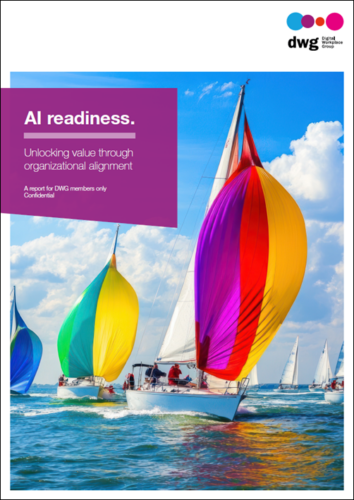Four key digital workplace takeaways from DWG24 2020
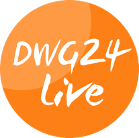 One of the reasons I love working in the digital workplace and intranet world is the opportunity to interact with the global community of digital workplace professionals, hear about their work and see how it is making a real difference to employees and organizations. DWG24, a 24-hour virtual festival run by Digital Workplace Group (DWG), has always been one of my favourite events for the professional community, providing a chance to learn, network and have fun all at the same time. DWG24 has been staged (under various different names – it started out as IBF24 and has also been DW24) several times since the first one back in 2008 and, in many ways, it has been a forerunner to many of the other virtual events we see today.
One of the reasons I love working in the digital workplace and intranet world is the opportunity to interact with the global community of digital workplace professionals, hear about their work and see how it is making a real difference to employees and organizations. DWG24, a 24-hour virtual festival run by Digital Workplace Group (DWG), has always been one of my favourite events for the professional community, providing a chance to learn, network and have fun all at the same time. DWG24 has been staged (under various different names – it started out as IBF24 and has also been DW24) several times since the first one back in 2008 and, in many ways, it has been a forerunner to many of the other virtual events we see today.
The 2020 edition of DWG24, held across 30 September to 1 October, again delivered a fascinating array of live intranet and digital workplace tours from leading organizations; there were also multiple sessions with thought leaders and fascinating insights from people truly innovating in the space.
If you missed the live show, you can catch up via the DWG24 2020 Video Library.
The event explored many of the prevalent themes that are happening right now across the digital world of work, such as employee experience, engaging first-line employees, increasing the digital confidence and literacy of the workforce, and how organizations have supported employees through the COVID-19 crisis. 2020 has been a year when digital workplaces and intranets have proved to be truly essential and DWG24 was a salient reminder that the work we do does make a difference.
I thoroughly enjoyed being involved in DWG24, both as a small part of the wider DWG team that prepared the content for the event and also as a contributor during three hours of the day. There are numerous highlights and insights, but here are just four of the takeaways from DWG24 2020 that stood out for me.
1. We still need to work on optimizing the physical workplace
With many of us working from home during the COVID-19 crisis, there has been a lot of attention given to remote and distributed working; most of the coverage relating to physical workplaces (or at least offices) has related to their long-term future. Across the DWG24 hours we heard from various experts about the importance of optimizing physical workplaces to the way people work, aligning them to organizational culture, working styles, collaboration and staying safe during the pandemic.
It was a good reminder that, despite the scaling up of remote working capability, the physical office is still very important. Many people are actually back at work in the office and often prefer working there; we look forward also to a time when it will be much safer to return to physical work environments. Physical workplaces can provide richer, face-to-face collaboration and social connection, which helps teams to gel. Most people I know enjoy having the choice, with a mixture of working both from home and with colleagues face to face.
One of my favourite sessions was from Jesper Ambrosius of Lego Group, talking about how LEGO is customizing both its digital and physical workplaces to drive productivity but also to align to the company’s unique culture. LEGO has created a specific programme around “Workplace Experiences”, which aims to deliver spaces that will “wow and inspire” and are “fun and playful”, among other ambitions. Attention is given very much to the process for designing workspaces, driven by a thorough understanding of employees, involving change agents and with the design process as part of the change management effort itself.
I particularly liked the fact that there is a dedicated space in LEGO’s digital workplace where employees can explore the different working spaces and how these are aligned to the company culture.
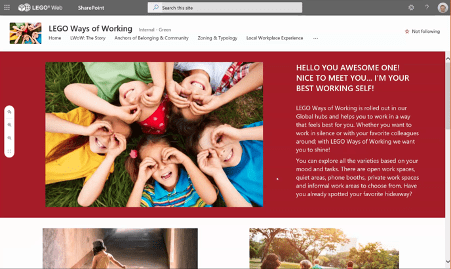
LEGO’s Ways of Working space within their digital workplace
2. Personalized intranets support employees in their daily work
Fundamentally, intranets and digital workplaces are about helping employees to get things done. While they also support employee engagement, a successful intranet should always help employees to find information and support essential workflows that they need to complete tasks, in so doing saving time and removing frustration. However, this can be challenging, especially when you have a highly diverse workforce with differing information needs.
Personalization is one of the keys to success, ensuring that relevant and essential content is targeted to the individual, based on their division, location, role, position in the org structure, and even preferences.
During DWG24 we saw an insightful tour of Region Skåne’s intranet from Jesper Bylund, one of the smartest intranet professionals around. Region Skåne is a regional public sector body in Sweden and its intranet is primarily targeted at healthcare workers, who work both in hospitals and across the community. Here, staff – particularly those in clinical practice – have very specific requirements based on their roles, needing to be able to access the right information quickly, especially during the current pandemic.
It’s no wonder then that Region Skåne’s intranet is based on a content strategy where 80% of the content is “local” and targeted to different needs, rather than meant for everyone. The homepage features multiple sections that are personalized, based on profile element, such as role and location. Underpinning this is content curation from role-based subject matter experts.
Making all this happen is very challenging, so the intranet team at Region Skåne are doing an important job. I love this screenshot below (translated), which shows resources for nurses with content managed by a healthcare professional. It’s not full of bells and whistles, but it’s helping busy nurses on the frontline find what they need.
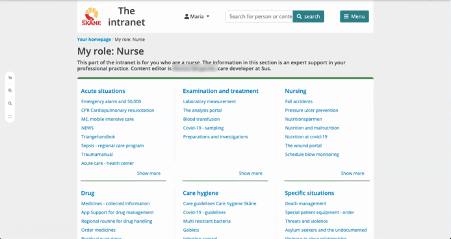
Region Skåne’s intranet helping frontline nurses find what they need
3. Digital literacy is essential across the digital workplace
Organizations invest millions of dollars in technology, but then don’t resource the necessary change management efforts to help employees get the most out of these tools – or they focus only on the initial roll-out. If you want to get the best out of your technology, you need to invest in long-term programmes that focus on truly changing behaviours across the digital workplace, increasing the digital literacy of employees and giving them the confidence to use the tools at their disposal.
During DWG24, we were lucky enough to get two live tours from VELUX, a global manufacturer of windows and skylights, based in Denmark. There’s lots to love about the VELUX digital workplace, including a smart new intranet roll-out, as well as a long-term digital literacy programme that is focused on helping employees get the best out of the VELUX digital workplace. We heard from Frederik Zebitz, the main person behind the company’s GET IT! programme.
There is a much to take away from how VELUX has implemented GET IT, including the benefits of:
- a long-term permanent programme rather than just one-off change campaigns
- establishing a recognizable “brand” and name for the programme
- a mixture of self-serve resources and targeted webinars to meet different needs and learning styles
- a scope that goes well beyond “how to” use software but also looks at the associated mindset
- using social networking tools like Yammer as a forum to ask questions and swap tips.
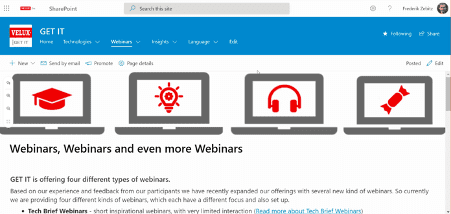
A screenshot from VELUX’s long term digital literacy programme, GET IT
4. Digital channels reflect and amplify the best parts of an organizational culture
Digital channels have an interesting kind of “symbiotic” relationship with organizational culture in that they reflect it but also have some reciprocal influence as well, ideally helping to amplify its positive aspects. I like employee and peer-to-peer recognition initiatives because these often accentuate the best parts of an organizational culture while also showcasing real employees who are doing great work; I think this usually sends a stronger message than more woolly “values statements”. A recognition programme can be a bottom-up initiative as well as a top-down one, ensuring that feedback resonates in a different and deeper way.
One of my favourite intranets is Duke Energy’s Portal. Martha Brown and her team have done some excellent work over the years, and we got another opportunity to revisit this during the 2020 DWG24. I love how Duke Energy celebrates employees and their achievements so prominently on the intranet homepage through a well-placed recognition feature, celebrating and amplifying Duke Energy’s people-centric culture.
This includes employee recognition (“High Fives”) but also people news, celebrations of long tenure (and the company has many long-serving employees) as well as customer success stories. A call to action encourages people to recognize the efforts of others; this sends a strong message that Duke Energy values the contribution of its employees, something that is important during these volatile times.
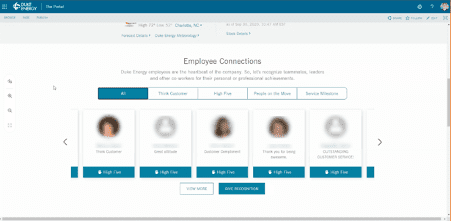
Duke Energy’s intranet supports its people-centric culture
If you missed the live show, you can catch up via the DWG24 2020 Video Library.
Take the next step…
Categorised in: DWG24

